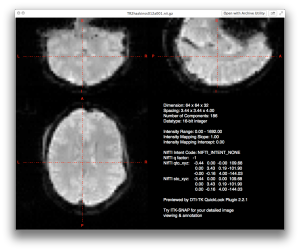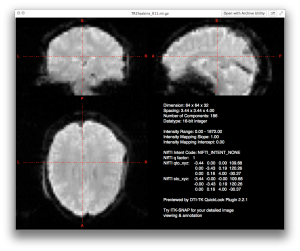I previously reviewed a series of DICOM to NIFTI converters. The entire purpose of this post is to state how important it is to check the orientation of the images coming out of any DICOM to NIFTI converter. The example today illustrates an incorrect flip in dcm2nii, but I want to stress that this happens with other converters from time to time.
I use dcm2nii for DICOM to NIFTI conversion in a lot of studies, it’s fast and gives consistent naming for the NIFTI files that it outputs. They give plenty of disclaimers when using it to check the left/right flip and orientation of the data. And I would say that the error rate is around 1/200. But when it does give the unexpected results, it’s pretty striking! As you can see in the image below, the brain is upside down, despite having an RAI orientation.
If I take the same DICOM files and convert it via Dimon (part of AFNI), I get the correct orientation of the files.
Visualizations thanks to the Mac Quicklook plugin. You can grab a copy at NITRC. If you are worried about different types of flips, you can tape a vitamin E tablet to your participants head while they are in the scanner. This tablet will be visible in both EPIs and anatomic data. Just make sure that you always put the tablet on the same side!
UPDATE:
It’s worth checking your version of dcm2nii. The newest version (June 2013) fixes all but one of my flipped brains!

